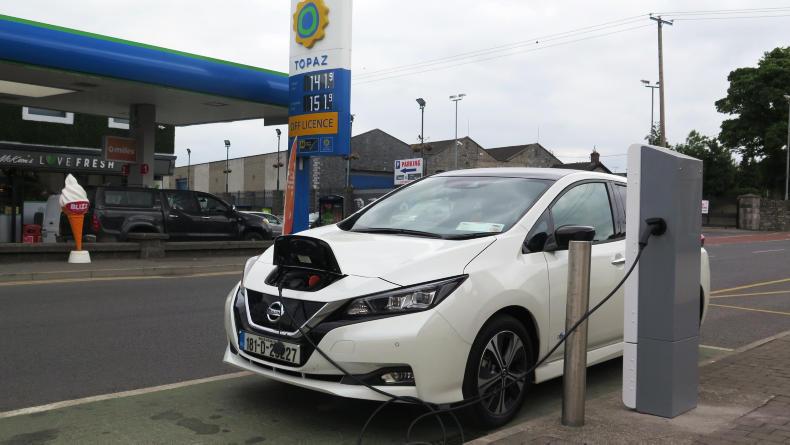There is a great community of knowledge and friendliness emerging around the electric car world as public charging points have become places of warm discussion, helped no doubt by the good weather of summer 2018. This new community of sharing was so evident when I took the latest Nissan Leaf on my usual lengthy test drives.

The Nissan Leaf has a spacious 435-litre boot that extends to 1,176 litres with the rear seats folded down.
Everywhere I stopped for a charging boost, I met either other Leaf drivers or people who were fascinated by the electric car concept.
And I learned so much about the car that I was driving, mainly from existing Leaf owners.
All were delighted to enthusiastically share their electric car driving experiences as we queued to get a turn at the charging point.
And, overall, there was not a bad word among them.
After over 1,000km of driving, not your typical electric car-driving profile, I have developed a new confidence in the car.
Driving an electric car in Ireland is about changing your mindset; you need to plan your journeys with charging at the other end or in between, always in mind.

The standard Nissan Leaf comes with 16in steel wheels, while the SV and SV premium models come with larger 17in alloy wheels.
My journeys to Cork, Portlaoise, Kells and Leitrim all required strategic planning. Fast charging also gives you new opportunities to become a coffee expert. I found I quickly created work opportunities during these charging intervals.
My overall impression is that the charging network still needs a lot more work. While the ESB phone app to locate the charging points is good, there are just not enough charging points out there.
The Nissan Leaf electric car is great, but it’s the charging network, especially in rural towns of Ireland, that lets you down.
While you can travel the country comfortably with careful planing, the range anxiety still takes some time to ease. Nobody likes the thought of having to walk home or be rescued.
Back to the new Nissan Leaf, which is a very impressive car. Firstly, it’s an attractive car, with modern car looks – a car that you would be proud to own.
On the inside, the Leaf comes with an improved 7in, full-colour (TFT) display to highlight key features, including information from the audio and navigation systems.
The standard navigation features also include real-time information on the nearest charge points of which there are not enough, just yet. Apple CarPlay and Android Auto are available through the system.
Charging app
The car has its own app to allow drivers to remotely get information about the charging level. It also allows you to adjust the climate control while the car is being charged, saving battery capacity, so that on those warm days it was possible to have the car cooled down in advance of returning to it, during one of those many coffee breaks.

With petrol prices jumping close to the €1.50/litre mark, owning an electric car such as the new Nissan Leaf makes sense with free on-street electric car charging in towns such as Kells, Co Meath, but there are not enough charging points to meet the growing demand.
The car’s performance has also been significantly improved compared with before, as the new electric drive system delivers 150bhp (110kW) of power and 320Nm of torque, a match for most cars in this size category.
With this comes improved acceleration performance at 7.9 seconds from 0km/h to 100km/h, making it the fastest car to accelerate in the C-segment of the market where the Volkswagen Golf and Ford Focus dominate the sales.
The new Nissan Leaf is the first electric vehicle to undergo worldwide harmonised light vehicle testing procedure (WLTP) and claims to deliver a range of up to 378km on the combined cycle, or higher in city conditions, on a single charge.
This is claimed to be a 50% increase over the previous generation Leaf.
The WLTP test is designed to reflect real-life situations more accurately.
This means that you can enjoy longer journeys by using the CHAdeMO quick-charging network, which is reasonably well catered for on the Irish motorway network.
We just need more of them, as Nissan alone has doubled its new electric car sales in Ireland from 224 in 2017 to 566 by the end of July this year. And used UK imports had shot up to 248 by the end of July, so the Leaf population is growing.
Charging time from low battery power alert to 80% (quick charging – 50kw) takes 40 to 60 minutes at one of the stops, while it is around 7.5 hours from alert to 100% with a 7Kw wall box, one of which I have at home.

The Nissan Leaf comes with two charging ports built into a neat panel on the front bonnet that’s opened by a button on the dash. The unit to the left is for fast charging, the one on the right for slower home and standard public charging.
There is a limit to the number of fast charging sessions in succession that you can do, or the system will shut you out to protect the battery, which prefers slow overnight charging.
Longer driving
Longer driving demands that you use the car’s adaptive cruise control to maximise its efficiency. I quickly came to terms with the Nissan Leaf’s e-Pedal technology.
This allows acceleration, deceleration and full stop with the simple increase or decrease of the pressure applied to the accelerator.
By releasing the accelerator, the car will decelerate and come to a complete stop, even hill holding, without the need to press the brake pedal.
The e-Pedal eliminates the need for drivers to constantly move their foot from the accelerator to the brake pedal to slow down or stop.
I found that this helps reduce fatigue and stress in daily town driving, and it meant that I was not using the brake pedal as I would in a conventional car.
The Leaf comes with lots of other intelligent mobility technology, including ProPILOT driver assistance for a safer, more comfortable drive and ProPILOT Park, for autonomous parking at the touch of a button.

The power unit for the Nissan Leaf generates 150bhp equivalent to give impressive 0 to 100km/hr acceleration of just 7.9 minutes and you can feel it.
The system was very effective on motorway driving. Just by activating the cruising control speed and car distance, it automatically adjusts the speed to match that of the traffic ahead and keeps the car in the centre of the lane.
In traffic jams, ProPILOT will automatically manage distance to the car in front and apply the brakes to bring the vehicle to a full stop, if necessary. After stopping, the car will remain in place even if the driver’s foot is off the brake.
Traffic
Once traffic restarts, the car will resume driving again automatically. If the traffic stops for over three seconds, ProPILOT will restart at a simple touch of the accelerator or by pressing on the steering wheel.
This new Nissan Leaf is also packed with safety features and it was recently awarded a Euro NCAP five-star safety rating.
The standard car comes with six airbags (front, side and curtain), ISOFIX hook, anti-lock braking system, electronic brake force distribution, brake assist and hill start assist.
The new Nissan Leaf means that the future of electric car driving is already here.
Entry prices start at €28,690 after the Government grant of €5,000, or £21,990 (after a £4,500 grant) in Northern Ireland.
This is a real car with good comfort, great handling and a decent boot.
Running costs are minimal as public charging remains free and an overnight home charge will cost you no more than €3. So it was safe to say that my 1,000km driving week cost me less than €20 (£18). My range anxiety evaporated as my journey planning improved. Do you need any more convincing?
There is a great community of knowledge and friendliness emerging around the electric car world as public charging points have become places of warm discussion, helped no doubt by the good weather of summer 2018. This new community of sharing was so evident when I took the latest Nissan Leaf on my usual lengthy test drives.

The Nissan Leaf has a spacious 435-litre boot that extends to 1,176 litres with the rear seats folded down.
Everywhere I stopped for a charging boost, I met either other Leaf drivers or people who were fascinated by the electric car concept.
And I learned so much about the car that I was driving, mainly from existing Leaf owners.
All were delighted to enthusiastically share their electric car driving experiences as we queued to get a turn at the charging point.
And, overall, there was not a bad word among them.
After over 1,000km of driving, not your typical electric car-driving profile, I have developed a new confidence in the car.
Driving an electric car in Ireland is about changing your mindset; you need to plan your journeys with charging at the other end or in between, always in mind.

The standard Nissan Leaf comes with 16in steel wheels, while the SV and SV premium models come with larger 17in alloy wheels.
My journeys to Cork, Portlaoise, Kells and Leitrim all required strategic planning. Fast charging also gives you new opportunities to become a coffee expert. I found I quickly created work opportunities during these charging intervals.
My overall impression is that the charging network still needs a lot more work. While the ESB phone app to locate the charging points is good, there are just not enough charging points out there.
The Nissan Leaf electric car is great, but it’s the charging network, especially in rural towns of Ireland, that lets you down.
While you can travel the country comfortably with careful planing, the range anxiety still takes some time to ease. Nobody likes the thought of having to walk home or be rescued.
Back to the new Nissan Leaf, which is a very impressive car. Firstly, it’s an attractive car, with modern car looks – a car that you would be proud to own.
On the inside, the Leaf comes with an improved 7in, full-colour (TFT) display to highlight key features, including information from the audio and navigation systems.
The standard navigation features also include real-time information on the nearest charge points of which there are not enough, just yet. Apple CarPlay and Android Auto are available through the system.
Charging app
The car has its own app to allow drivers to remotely get information about the charging level. It also allows you to adjust the climate control while the car is being charged, saving battery capacity, so that on those warm days it was possible to have the car cooled down in advance of returning to it, during one of those many coffee breaks.

With petrol prices jumping close to the €1.50/litre mark, owning an electric car such as the new Nissan Leaf makes sense with free on-street electric car charging in towns such as Kells, Co Meath, but there are not enough charging points to meet the growing demand.
The car’s performance has also been significantly improved compared with before, as the new electric drive system delivers 150bhp (110kW) of power and 320Nm of torque, a match for most cars in this size category.
With this comes improved acceleration performance at 7.9 seconds from 0km/h to 100km/h, making it the fastest car to accelerate in the C-segment of the market where the Volkswagen Golf and Ford Focus dominate the sales.
The new Nissan Leaf is the first electric vehicle to undergo worldwide harmonised light vehicle testing procedure (WLTP) and claims to deliver a range of up to 378km on the combined cycle, or higher in city conditions, on a single charge.
This is claimed to be a 50% increase over the previous generation Leaf.
The WLTP test is designed to reflect real-life situations more accurately.
This means that you can enjoy longer journeys by using the CHAdeMO quick-charging network, which is reasonably well catered for on the Irish motorway network.
We just need more of them, as Nissan alone has doubled its new electric car sales in Ireland from 224 in 2017 to 566 by the end of July this year. And used UK imports had shot up to 248 by the end of July, so the Leaf population is growing.
Charging time from low battery power alert to 80% (quick charging – 50kw) takes 40 to 60 minutes at one of the stops, while it is around 7.5 hours from alert to 100% with a 7Kw wall box, one of which I have at home.

The Nissan Leaf comes with two charging ports built into a neat panel on the front bonnet that’s opened by a button on the dash. The unit to the left is for fast charging, the one on the right for slower home and standard public charging.
There is a limit to the number of fast charging sessions in succession that you can do, or the system will shut you out to protect the battery, which prefers slow overnight charging.
Longer driving
Longer driving demands that you use the car’s adaptive cruise control to maximise its efficiency. I quickly came to terms with the Nissan Leaf’s e-Pedal technology.
This allows acceleration, deceleration and full stop with the simple increase or decrease of the pressure applied to the accelerator.
By releasing the accelerator, the car will decelerate and come to a complete stop, even hill holding, without the need to press the brake pedal.
The e-Pedal eliminates the need for drivers to constantly move their foot from the accelerator to the brake pedal to slow down or stop.
I found that this helps reduce fatigue and stress in daily town driving, and it meant that I was not using the brake pedal as I would in a conventional car.
The Leaf comes with lots of other intelligent mobility technology, including ProPILOT driver assistance for a safer, more comfortable drive and ProPILOT Park, for autonomous parking at the touch of a button.

The power unit for the Nissan Leaf generates 150bhp equivalent to give impressive 0 to 100km/hr acceleration of just 7.9 minutes and you can feel it.
The system was very effective on motorway driving. Just by activating the cruising control speed and car distance, it automatically adjusts the speed to match that of the traffic ahead and keeps the car in the centre of the lane.
In traffic jams, ProPILOT will automatically manage distance to the car in front and apply the brakes to bring the vehicle to a full stop, if necessary. After stopping, the car will remain in place even if the driver’s foot is off the brake.
Traffic
Once traffic restarts, the car will resume driving again automatically. If the traffic stops for over three seconds, ProPILOT will restart at a simple touch of the accelerator or by pressing on the steering wheel.
This new Nissan Leaf is also packed with safety features and it was recently awarded a Euro NCAP five-star safety rating.
The standard car comes with six airbags (front, side and curtain), ISOFIX hook, anti-lock braking system, electronic brake force distribution, brake assist and hill start assist.
The new Nissan Leaf means that the future of electric car driving is already here.
Entry prices start at €28,690 after the Government grant of €5,000, or £21,990 (after a £4,500 grant) in Northern Ireland.
This is a real car with good comfort, great handling and a decent boot.
Running costs are minimal as public charging remains free and an overnight home charge will cost you no more than €3. So it was safe to say that my 1,000km driving week cost me less than €20 (£18). My range anxiety evaporated as my journey planning improved. Do you need any more convincing?






















SHARING OPTIONS